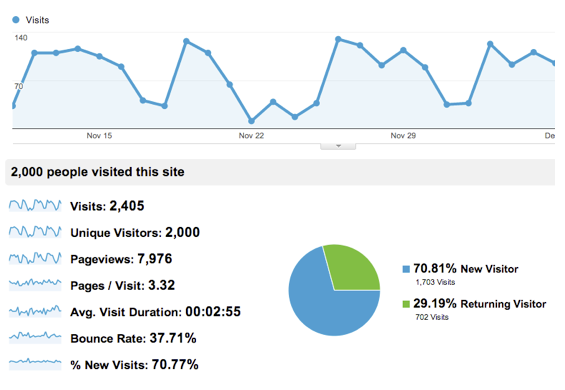The Audience Overview report is the first page we see upon opening our Google Analytics. But what do all these numbers mean and why should we care?
Below I’ll spotlight each metric and what you need to know about it:
Visits: the total number of times your site has been visited.
Unique Visitors: the number of individuals who have visited your site.
"Visits" are not the same as "unique visitors." For example, if Santa visits a house 12 times, Santa is considered one unique visitor with 12 visits.
Do not use these terms interchangeably. Consider the difference between: "I've had 12 people come down my chimney" versus "this one guy has come down my chimney 12 times."
Why should you care?If you want to measure activity in the context of people, use the unique visitors metric. This is best way to measure how many individuals have come to your site.
Pageviews: the total number of pages viewed on your Website by all visitors.
Why should you care? You shouldn’t. This metric is useless to most people. The exception is site owners who are paid to run ads on their site. The more pageviews, the more ad impressions and the more revenue. If you don’t run ads, you’re best off ignoring this number.
Pages/Visit (Pages per Visit): average number of pages viewed on your Website per visit.
Why should you care?This metric can be a loose indication of how engaging your site is. The more pages people view when coming to your site, the more engaged they are, right?
Not necessarily.
Visitor A may be in love with your content, clicking through to five different pages. But Visitor B is incredibly frustrated with your site navigation, and has clicked around to five different pages. Ultimately, they leave without converting. Both visitors viewed five pages, but each had a very different experience.
Is Pages per Visit a useless metric? No, but don’t use it by itself. Compare it with outcomes, such as conversion rate. Do people who visit more pages per visit convert at a higher rate? If so, what page combinations result in more conversions? Are there ways to make these pages more accessible via changes to your navigation or links in your page content?
Pages per Visit is also useful for sites who host ads. The more pageviews, the more ad revenue. This is why many sites divide one story into multiple pages, or why you see so many “The 25 Best ________ Of All Time” or “The Worst _____ of the Year” articles, which require you to click through to a new page for each item on the list. Each visitor turns into 25 pageviews, which results in 25x more ad revenue.
Average Visits Duration: the average length of time someone spent on your Website.
Why should you care?Just like Pages per Visit, this metric should be used to find meaningful correlations. For example, do visitors who spend more than two minutes on the site convert at a higher rate than visitors who stick around for less than one minute?
If so, what do they spend their time doing? What pages are converting visitors spending the most time on? What is it about the content on those pages that is increasing the likelihood for conversions?
Also, like pages per visit, a high average visit duration can suggest difficulties in navigation layout or the ability to find key pages. Be cautious when using this metric by itself (as tempting as it may be). Put it in the context of outcomes whenever possible.
Bounce rate: the percentage of visitors who viewed only one page before exiting your site (I walked in, I took one look, and I walked right back out).
Why should you care? Unlike most metrics, bounce rate can be used by itself, without the context of other metrics. It is a wonderful way for measuring the first impression made by your site. A site that cannot capture someone’s attention right away will likely result in them turning around and walking right back out (a bounce).
Aim for a bounce rate in the 30-40 percent range - the lower, the better. Anything below 30% is great, but can be very difficult to obtain. Sustaining a bounce rate below 20% is unrealistic is most cases. Get your bounce rate in the 30’s and you’re in good shape. If you’re above 60%, you may have major issues with your site.
% New Visits: the percentage of visitors who are coming to your site for the very first time.
Why should I care? A good website that’s marketed well should be capturing new visitors on a regular basis. It should also provide a pleasant enough experience that makes visitors want to return.
A very high distribution of new visitors (>85%) means your site does a poor job of convincing people to come back. A high distribution of returning visitors suggests your online marketing is not effective or aggressive enough.
Loyalty is important, but gaining new customers is what it’s all about. I consider a healthy mix to be around 70-75% new visitors and 25-30% returning visitors. Based on your industry, your mileage may vary.












Agree, disagree, or just have something to add?
Leave a comment below.